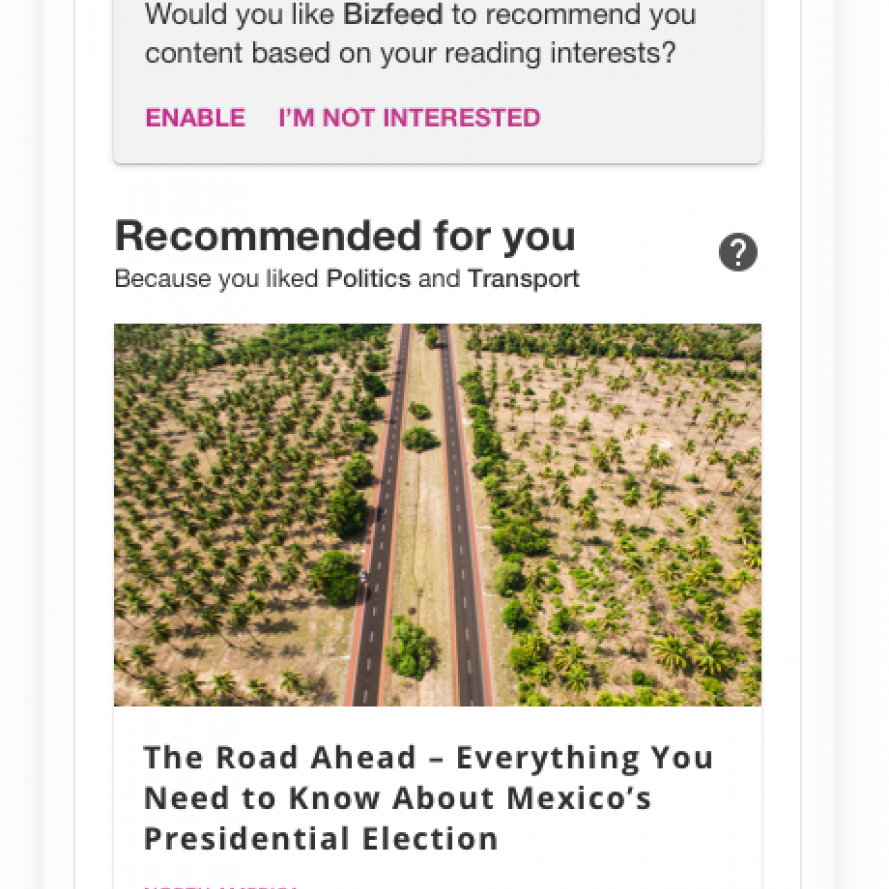How might we...
...… Allow people to take an active part in shaping recommendation algorithms and how the service will use their data
One size fits none. Providing people with tailored experiences is proven to help retention. Nonetheless, surfacing what data will be used to achieve this level of personalisation and how it will be used is crucial - and requires people’s consent. While this is never an easy task, it gets trickier when trying to explain how different types of data are related to each other within an app.
In order to provide news that is relevant to its readers, Bizfeed matches behavioral data (observed reading habits) and manually inputed personal information (reading preferences).
How can we build consent patterns to go beyond compliance and turn it into an opportunity to build transparent and personalised experiences?

Bizfeed is a business and economy news platform displaying articles and videos. To provide this service and improve the user experience, Bizfeed uses the following information:

How might we...
...… Allow people to take an active part in shaping recommendation algorithms and how the service will use their data
Bizfeed suggests new content based on how the app is being used, including what people read, like and comment. It is vital to generate awareness of and get informed consent for how people’s behaviour will generate inferred data that will in turn be interpreted by the service. The app empowers people by presenting this feature clearly and offering a way to opt out.

Creating an onboarding process in which people are able to personalise their feed before actually interacting with it is a common practice. In this case, selecting categories is a simple, efficient first step to get insights on how to best leverage people’s data in a way that fits their interests.

In addition, being explicit about which pieces of content are actually being recommended by an algorithm would be a first step towards transparency. But sometimes people may want to take an active part in shaping their own feed by manually tuning it. No-one should have to be an AI engineer to be able to enjoy a transparent and relevant service.
Relying on common habits, such as sharing appreciation after reading an article, the app uses a simple like/dislike section at the bottom of the screen to prompt people to take a conscious decision on how they want to influence the curation of their feed. As this has become a common interaction pattern, it does not require much extra thinking for people using the app.

Bizfeed is empowering people by bringing an additional layer of transparency through nothing more than a single line of text using simple language to explain that likes and dislikes will be used to curate people’s personalised feed.
In addition to generating data use awareness through contextual controls, Bizfeed offers a clear visualisation of the information gathered on a separate dashboard. This allows the service to provide additional details - ultimately generating an improved understanding of people’s own reading habits and how they shape their own customised experience of the service.

Data controls are often looked down upon as features that will make for a restrictive, annoying user experience and therefore get in the way of product and service success. Bizfeed demonstrates instead that letting people have a say in how a product would better fit their needs articulates the value exchange for a relevant service. Not only does it encourage early adoption by providing an enjoyable experience from the get go, but it can adapt to people’s tastes over time.
How might we design with sustainability and retention in mind over early adoption and infinite growth?